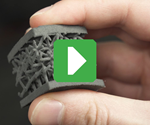How 3D Printing Enables More Sustainable Designs (Video #2)
The circular economy needs the lightweight, optimized and efficient designs that only 3D printing can provide. More in this video, part of our series on 3D Printing and the Circular Economy.
3D printing will be key to establishing a circular economy in part for the design advances it makes possible. As a digital manufacturing technology, 3D printing supports lightweight, complex and optimized geometries that would not be possible to make any other way. As a result, 3D printed parts and products can better serve their intended purpose, whether that goal is as large as reducing fuel consumption for a jet engine or as personal as creating a pair of shoes that better fits the wearer.
But the benefits from additive manufacturing (AM) begin before the item ever gets to the consumer. Design possibilities from 3D printing can help make the manufacturing process easier, faster and more sustainable. Learn more in the video below, the second in our series on 3D Printing and the Circular Economy. Join the conversation all week on social media using the hashtag #CircularEconomyWeek.
Resources and Related Links
- Videos in this series: What Is the Circular Economy? | Materials | Design | Manufacturing | Product | End-of-Life
- Generative design brings weight and cost savings for micromobility vehicle
- Parametric design supports on-demand manufacturing, and design-to-order
- Topology optimization versus generative design
Transcript
Welcome to our video series on 3D printing and the circular economy. In this video we'll be talking about design.
The circular economy needs additive manufacturing, but more specifically, it needs the designs that additive manufacturing can enable. There are a couple of different ways that 3D printing can support more sustainable designs. The first is by simplifying manufacturing. We know that 3D printing is great at things like assembly consolidation, if you're able to take something that used to be a couple of different parts put together and print them as just one piece, you're reducing the use of fasteners, you're reducing the number of materials and you're also reducing the hand labor necessary to make that part.
Another way that 3D printing can support more sustainable designs is through optimization. We have all of these software tools — generative design, topology optimization — that allow us to build exactly the right 3D printed part. They can be more lightweight, they're more efficient, and they're better for whatever purpose they're intended to serve.
Finally, 3D printing can support better end-of-life scenarios. If you are able to consolidate an assembly, for example, reduce the number of fasteners, the different types of materials, you're creating a product that's going to be much easier to recapture and turn into something else at the end of its lifecycle. By thinking about all of these things in the design stage, you can end up with a product that's much more circular much more sustainable. Learn more at gbm.media/circularAM and AdditiveManufacturing.Media. Thanks for watching.
Related Content
-
Preassembled Turbojet Engine, 3D Printed in One Build: The Cool Parts Show #75
Turbojet engines typically consist of hundreds or thousands of parts, but this engine — 2023 winner of The Cool Parts Showcase for Best Proof of Concept — was 3D printed as just two pieces, with the monolithic rotor embedded inside the stationary engine shell.
-
Velo3D Founder on the 3 Biggest Challenges of 3D Printing Metal Parts
Velo3D CEO and founder Benny Buller offers this perspective on cost, qualification and ease of development as they apply to the progress of AM adoption in the future.
-
3D Printed Lattice for Mars Sample Return Crash Landing: The Cool Parts Show Bonus
NASA Jet Propulsion Laboratory employs laser powder bed fusion additive manufacturing plus chemical etching to create strong, lightweight lattice structures optimized to protect rock samples from Mars during their violent arrival on earth.

.jpg;width=70;height=70;mode=crop)












